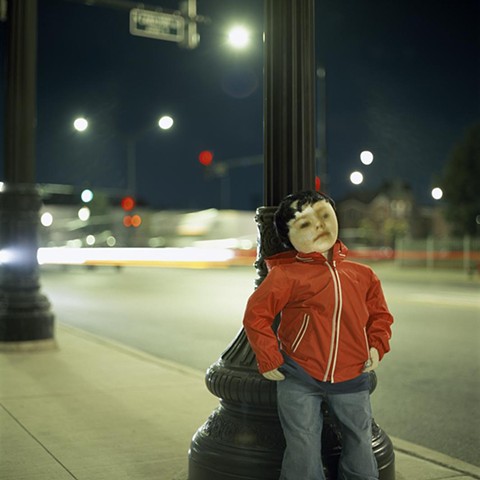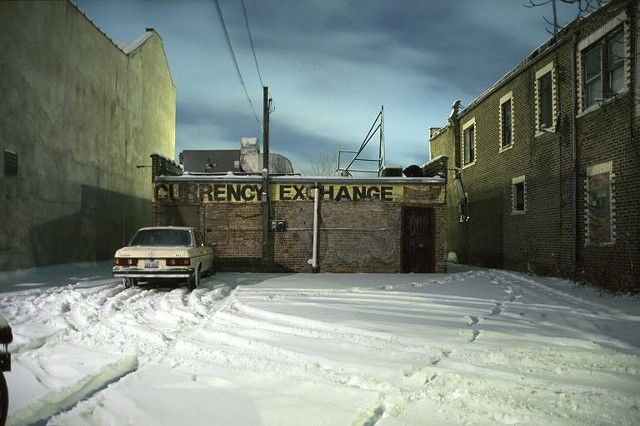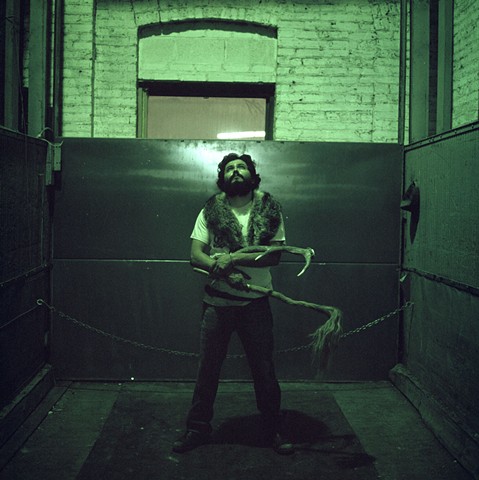Slate
Scenes From an Unhappy Childhood, Hauntingly Re-Created With Mannequins
By David Rosenberg
April 01, 2015Ursula Sokolowska, who moved from Poland to the United States when she was 5, doesn’t have a lot of positive childhood memories. The early part of her life was dominated with feelings of “helplessness, excommunication, and constant movement.” So, as a way to work through those memories, in 2006 Sokolowska created the series “The Constructed Family,” which uses personal childhood imagery projected onto soft-form mannequins to recreate her past.
At first the series wasn’t autobiographical, but, after writing about her childhood, she felt placing herself into the projections would be a better fit. She bought some child-size mannequins on eBay and used photographs of herself from infancy until around 7 years old that expressed her feelings during those years. She then projected the images onto the mannequins she placed in environments.
“I’ve always been drawn to spaces with light that have more of an urban, rugged feel,” she said. “The spaces feel more raw which is what I like to shoot in general, so the series was also getting back to that raw or early place in my life.”
Most of the series was shot around the Chicago area where Sokolowska lives, although she also took some of the images in Krakow during a trip in 2007—her first time since moving to the United States.
The images she uses aren’t meant to be a literal retelling of what she experienced as a child. “It’s reflective of my early childhood but it also shows how it resonates into being an adult,” she said. “It’s a type of haunting, the feeling of a certain type of abandonment or the kind of feeling that resonates in a person depending on their childhood and feeling left alone or pushed to the side.”
Most of the images used in the series are of Sokolowska and her mother, with whom she now has a much better relationship. Her father passed away around the time she was working on the series, and she said that creating a mannequin to represent him was extremely difficult.
“Memory and the brain are very fascinating. … We all remember things a certain, subjective way but we also ask ourselves, did it happen that way? Was it that good or was it that bad?”
NEWCITY Chicago
Known Artists, New Works - Schneider Gallery
by Michael Weinstein
July 25, 2011In this carefully selected summer photo show of fourteen accomplished, intelligent and distinctive gallery artists from around the world, Ursula Sokolowska stands out for her unsparingly direct straight color shots of gritty commercial and warehousing neighborhoods right here in Chicago. Perhaps it seems perverse to single out Sokolowska from a field that includes such global luminaries as Lalla Essaydi, Magdalena Campos-Pons, Luis Gonzalez Palma and our own Patty Carroll—and they are all here to their best effect—but Sokolowska makes their ingenious and insightful turns seem contrived when placed up against the world we live in that she has revealed in ominously illuminated color archival pigment prints. Who needs scenarios, set-ups and poses if we let Sokolowska transport us to the back lot of a dingy brick currency exchange on Union Street on a winter day after a snow, under a smudged aqua sky, where a lone gleaming white Mercedes sits parked? Had there been thirteen realists and one devotee of the imaginary, it might have been different.
NEWCITY Chicago
A New Angle/Schneider Gallery
by Michael Weinstein
May 24, 2010For its traditional summer genre show that features contemporary developments in time-honored photographic forms, the gallery has brought together four gifted portraitists, each of whom proceeds along a different path and projects a distinctive sensibility. Ursula Sokolowska’s color scenario studies of distressed people in decrepit environments exude an ominous sense of bitter oppression; Jess Dugan’s black-and-white environmental portraits—presented as triptychs—are warm and relaxed without being smarmy; and Jennifer Greenburg’s color images documenting the diehard devotees of the 1950s rockabilly lifestyle are consummated without a trace of ironic superiority or a hint of a sneer. The bold experimentalist in the show is Saudi Arabian photo-artist Jowhara AlSaud, who takes snapshots of friends and family and then etches out the negatives to create dynamic minimalist photo-cartoons that pack a powerful emotional punch just by virtue of their absence of detail. Having eliminated their facial features, but leaving their hair and the patterns on their blouses intact, AlSaud captures the vibrancy of three women pressed against each other in convivial friendship.
Northings-Highlands Islands Arts Journal
The Travelling Gallery Exhibition, Scotland
GEORGINA COBURN
25 March 2008The selection of work by Shaun Gladwell, Greg Grant, Kenny Hunter, Hideko Inoue, Oscar Muñoz, Ursula Sokolowska, Nafeesa Umar and Frances Upritchard made me ponder at length the whole question of access to images and visual literacy. I thoroughly enjoyed the way in which visual, tactile and conceptual elements combined, each piece was thought provoking and complex in its own way, delivered without the usual package of obstructive jargon.
In total contrast Ursula Sokolowska’s work projects her own face as a child onto mannequins in order to give a voice to the child figure as self portrait. Although her work is deeply personal, examining "the trauma and uncertainty carried from (her own) childhood" as a Polish immigrant, these photographic images are also a reflection of separation of the body from consciousness and objectification.
The two Untitled images on display, ’106’ and ’39’ are equally uneasy and disturbing. However, there is a feeling of creative reconstruction in the artist’s examination of her past which is ultimately empowering. Both photographic images are extremely complex in terms of the manner in which the figure is treated. They act on personal memory, fear and the familiar in a way that is uncomfortable and powerful. Like many of the artists in this show Sokolowska’s work begs further investigation.
NEWCITY Chicago
Tip of the Week
Ursula Sokolowska
by Michael Weinstein
Published 12 / 2006Yet another conceptual photographer festooning the walls of Chicago galleries in defiance of the holiday spirit, Polish-born Ursula Sokolowska presents a grim reflection on her troubled childhood in color shots of mannequins representing herself placed in real-world environments that she associates with her past. Always poignant and never cracking even the faintest smile, Sokolowska's surrogate expresses a narrow gamut of emotions ranging from stoical despondency through wary suspicion to outright fright as she stands alone on street corners, plods sadly across rubble-filled lots and lies sleeping in bed with pursed lips betokening the cruelest dreams. In the show's emblematic image, Sokolowska's proxy has been consigned to a dank basement where she stands lugubriously with her arm around a child mannequin who exudes even deeper pathos.
Chicago Tribune
By Alan G. Artner
Tribune art critic
Published December 15, 2006Ursula Sokolowska is a Chicago-based photographer who has created her images for some time with projections. I recall previous works she made with her younger brother as a model, but her new series at the Schneider Gallery delves into family relations more deeply--and creepily.
All of the color prints have blank-faced dolls and cloth mannequins that stand in for the artist, her mother and brother. Onto the blanks, she has projected faces found in old family photographs. The creations represent the artist, her mother and brother in restagings of difficult scenes recalled from Sokolowska's childhood.
The most potent ones capture small children ignored or abandoned on the street at night, or in bare, bleak interiors. Some of their strength comes from the situations, but much more is owing to the pale, oddly shaped faces that "fit" the dolls' bodies irregularly and register with the viewer as expressionistic distortions.
The strongest pieces, in which a small girl protects an even smaller brother, convey some of the threat of Charles Laughton's dark fairytale film, "The Night of the Hunter" (1955) updated to contemporary places and spaces in Chicago. In other words, the personal has been successfully raised to the level of universal nightmare.


